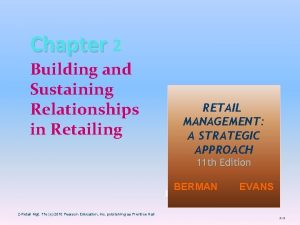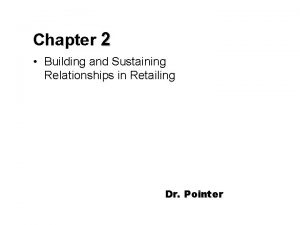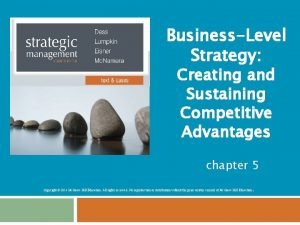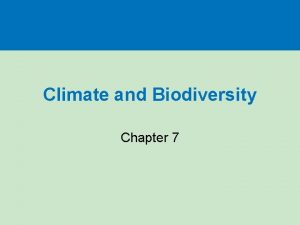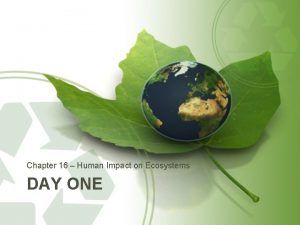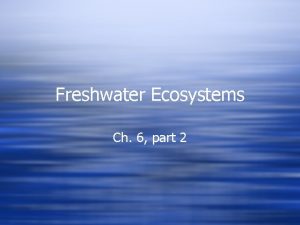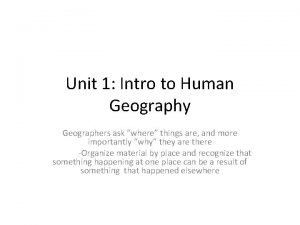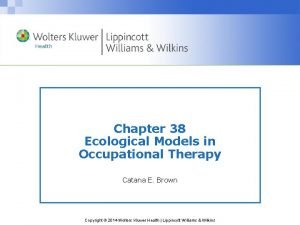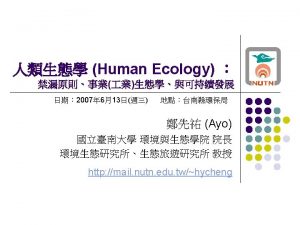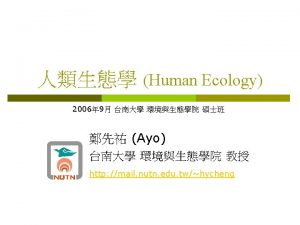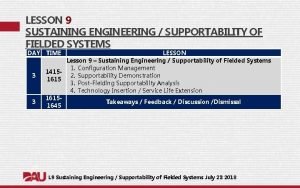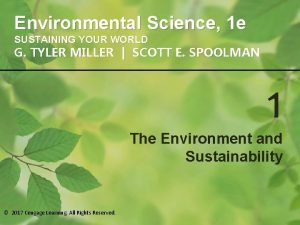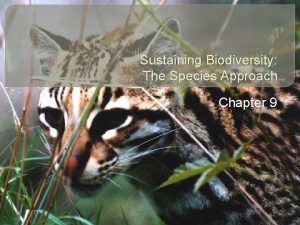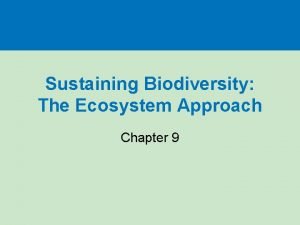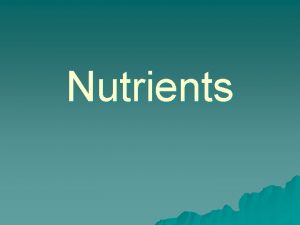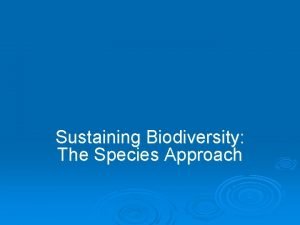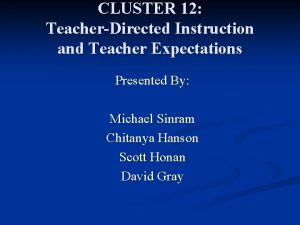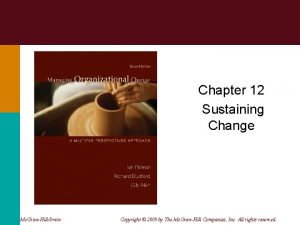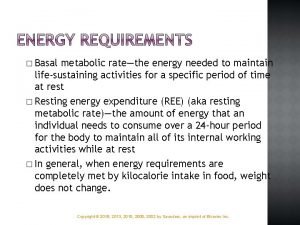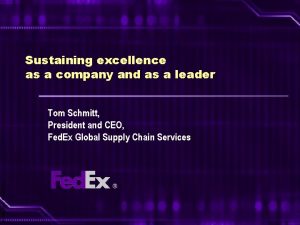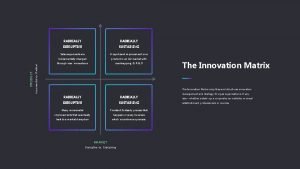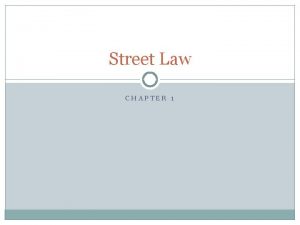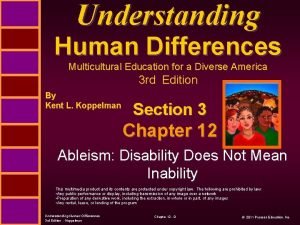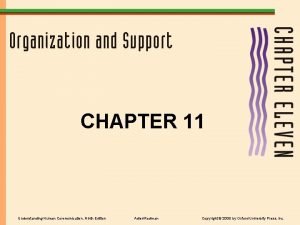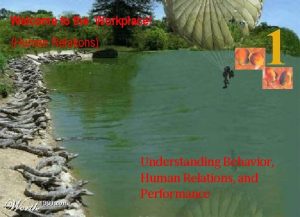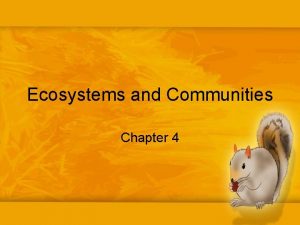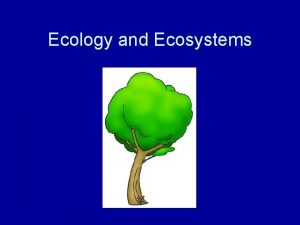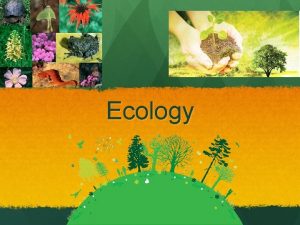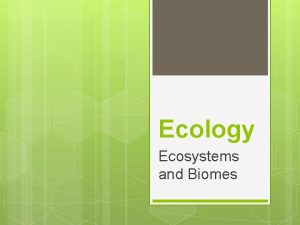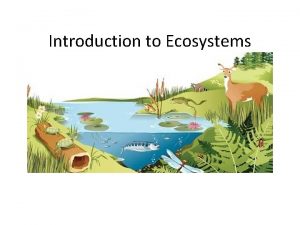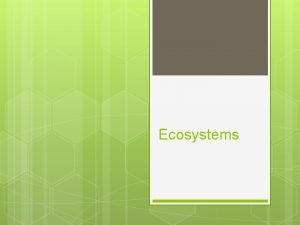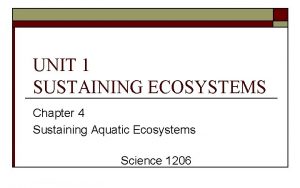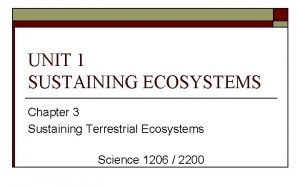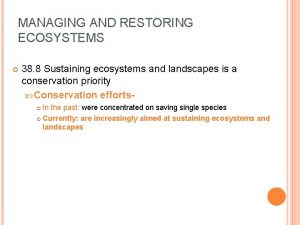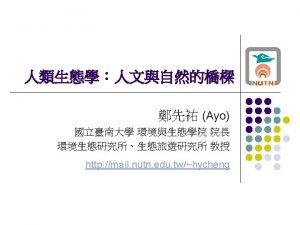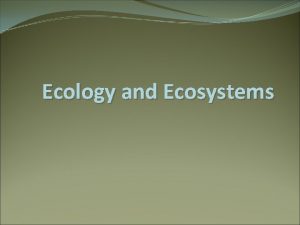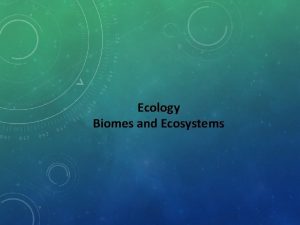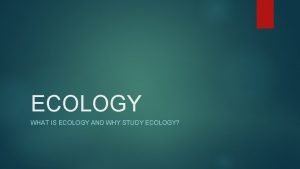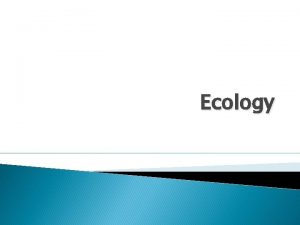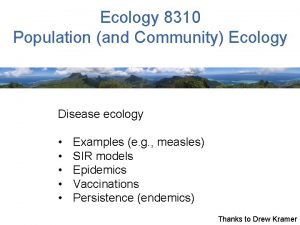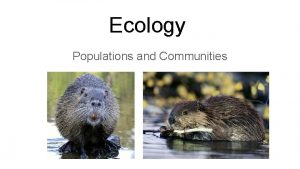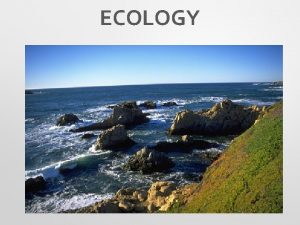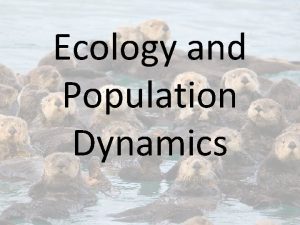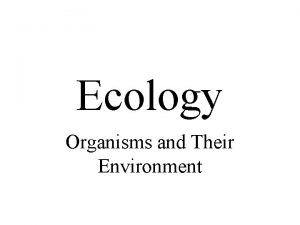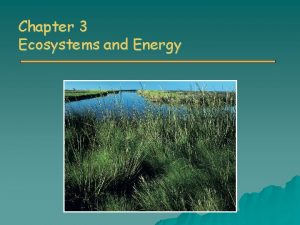Sustaining Ecosystems and Human Activity Understanding Ecosystems Ecology











































- Slides: 43

Sustaining Ecosystems and Human Activity Understanding Ecosystems

Ecology: • the study of the interaction of living things with each other and with the non-living factors in the environment

Sometimes these interactions are disrupted by the introduction (either accidentally or deliberately) of an Invasive Species – a species that is not native to an area. For example: The Round Goby • fish that is not native to the Great Lakes • appeared in 1990’s • brought over accidentally by ships from Europe • no natural predators • lay many eggs, twice a year

• aggressively defend spawning areas • greedy bottom feeders • less food for other species

Another Species to Watch: The Disappearing Frog

The following could be causes of a declining frog population: loss climate of change habitat Frog Decline UV radiation pollution

Life on Earth • A habitat is the place where an organism lives. • It includes the space as well as the other organisms • Terrestrial habitats exist on land, while aquatic habitats are found in the water. • the earth is surrounded by a thin layer of gas called the atmosphere.

• this gas layer keeps the Earth’s temperature just right • contains O , CO , N 2 2 2 and water vapour for living things • blocks out harmful solar radiation

• the water on the planet Earth is called the hydrosphere • the solid part of the Earth is called the lithosphere • The biosphere is all of the places on the planet where life can exist

Introducing Ecosystems • An ecosystem is all the living and non-living things in a particular area • the living part an ecosystem is the biotic component (wasps, perch, pine trees, microorganisms and fungi) • the non-living part is called the abiotic component (water, rocks, air and weather)

• the biotic and abiotic components are all related • when a component is changed, everything can be affected (Ex: Round Goby) • Ecosystems can be as large as an entire forest or as small as a rotting log

• members of the same species living in an ecosystem are called a population (all of the white-tailed deer in Short Hills Provincial Park) • a species is a group of organisms that can naturally reproduce together • all of the populations of different species form a community (all of the different species living in Short Hills Provincial Park)

Sustainability

• most natural ecosystems are sustainable • a sustainable ecosystem is one that survives and works well over time • natural ecosystems occur where there is little influence from man • man-made ecosystems, such as parks, are protected and maintained by humans

• • • The Case of Easter Island Is thought to have once been a thriving island People built statues and lived in forested area People cut down trees to grow crops, to burn as a heat source, until there were no more trees This lead to erosion, loss of plants as a food source, no extra materials to make houses, boats The island could no longer support the human population and society began to die off Only the statues remain



• human actions such as cutting down trees, oil spills and the planting of different plant species can change an ecosystem • natural events, such as forest fires and floods can also change an ecosystem • ecosystems supply resources for humans (lumber, medicine, seafood)

• these resources need to be managed so that they are sustainable • natural ecosystems are also used for recreation • “take only pictures” and “leave only footprints” • even the footprints can be a problem!

Interactions in the Ecosystem

• every species interacts with its environment • these interactions are referred to as the species ecological niche • niche includes what a species eats, what eats it, where it lives and how it behaves

There are different types of consumers: • herbivore (eat producers/plants) • carnivore (eats consumers/animals) • omnivore (eats producers & consumers) • scavenger/decomposer (feeds on dead or decaying organisms)

• consumers that eat plants are also called primary consumers • secondary consumers such as carnivores, eat other consumers • a consumer that eats a secondary consumer is called a tertiary consumer

• the transfer of energy from the sun to a producer, primary consumer, secondary consumer and so on is called a food chain

Hawk quaternary consumer top carnivore Snake tertiary consumer carnivore Frog Grasshopper Grass secondary carnivore or consumer omnivore primary herbivore consumer producer


ENERGY FLOW IN THE FOOD CHAIN • each level of production or consumption in the food chain is called a trophic level • the arrows in a food chain represent energy transfer • most of this energy is used for life functions or lost as heat • only a fraction of the energy transferred to an organism is passed on to the next level

Food Chain Pyramids • food chains can also be illustrated using pyramids • There are 3 main types:

i) Pyramid of Numbers Shows the population of each level in a food chain.

ii) Pyramid of Biomass - shows the dry mass of each trophic level

iii) Pyramid of Energy - Shows the energy of each trophic level - Most useful of the pyramids

• real feeding relationships are more complex • most consumers have more than one source of food • several food chains interconnected form a food web

Black Bear Cougar Deer Hawk Grouse Chipmunk Groundhog Robin Berries Grass Seeds


Energy Flow in Ecosystems

• Radiant energy from the sun supports life on Earth • Only about 0. 025% is absorbed by plants for this purpose • the remainder is absorbed (70%) or reflected (30%)

• Sun provides energy for photosynthesis • Produces food (glucose) and oxygen • Plants are called producers because they make their own food • carbon + water glucose + oxygen dioxide light energy chlorophyll

• energy is stored in glucose • plants use much of this energy for themselves • producers release oxygen during this process of photosynthesis

• the energy that is not used can be passed on to other organisms that cannot make their own glucose • recall that organisms that cannot make their own food are called consumers • when consumers eat food, the energy is released through cellular respiration

glucose + oxygen carbon + water + energy dioxide • photosynthesis and respiration are complementary processes • the reactants of one are the products of the other

Biotic Interactions • • The interaction between members of two different species that live together in a close association. You may not see any interaction from the surface. between the sea anemone and the clown fish. The clown fish eats animals that are attracted to the sea anemone and the fecal matter from the fish feeds the sea anemone There are three main types of symbiotic relationships: 1. Mutualism- both organisms benefit from the relationship Oxpecker and zebra ex. 2. Commensalism- one organism benefits while the other is unaffected ex. barnacles 3. Parasitism- one organism benefits at the cost of the host ex. fleas

• • Predation When one organism consumes another organism for food The consumed organism is called prey and is eaten by the predator • This lady bug is the predator for aphids (a bug that destroys many crops).

• • Competition Occurs when two or more organisms compete for the same resource such as food in the same location at the same time. Dandelions compete with the grass for same resources; water, nutrients and light 2 TYPES: i) Interspecific Competition – competition between different species ex. Cat and hawk for a mouse ii) Intraspecific Competition – competition within the same species ex. 2 cats for a mouse
 Phosphorus cycle pearson education
Phosphorus cycle pearson education Chapter 55 ecosystems and restoration ecology
Chapter 55 ecosystems and restoration ecology 3 aspects of value-oriented retail strategy
3 aspects of value-oriented retail strategy Building and sustaining relationships in retailing
Building and sustaining relationships in retailing Porters 3 generic strategy
Porters 3 generic strategy Building and sustaining relationships
Building and sustaining relationships Human impact on terrestrial ecosystems
Human impact on terrestrial ecosystems Chapter 16: human impact on ecosystems answer key
Chapter 16: human impact on ecosystems answer key Chapter 16 human impact on ecosystems
Chapter 16 human impact on ecosystems Lentic ecosystem
Lentic ecosystem Cultural ecology ap human geography
Cultural ecology ap human geography 3 pillars of sustainability ap human geography
3 pillars of sustainability ap human geography Ecology of human performance model
Ecology of human performance model Human ecology
Human ecology Human ecology
Human ecology Sustaining engineering definition
Sustaining engineering definition Environmental science sustaining your world answers
Environmental science sustaining your world answers How can you mobilize and sustain commitment
How can you mobilize and sustain commitment Apes chapter 9 sustaining biodiversity
Apes chapter 9 sustaining biodiversity What is the ecosystem approach to sustaining biodiversity
What is the ecosystem approach to sustaining biodiversity Substances that nourish the body
Substances that nourish the body Ways to protect the ecosystem
Ways to protect the ecosystem Sustaining expectation effect
Sustaining expectation effect Sustaining change
Sustaining change The energy needed to maintain life-sustaining activities
The energy needed to maintain life-sustaining activities Sustaining excellence
Sustaining excellence Sustaining vs incremental innovation
Sustaining vs incremental innovation Chapter 1 activity understanding street law
Chapter 1 activity understanding street law Debye huckel limiting law
Debye huckel limiting law Understanding human differences 5th edition
Understanding human differences 5th edition Adler and rodman 2006
Adler and rodman 2006 Understanding human communication 14th edition
Understanding human communication 14th edition Understanding human relations
Understanding human relations Reactants, products, and leftovers
Reactants, products, and leftovers Aoa and aon networks
Aoa and aon networks Activity 1 introductory activity
Activity 1 introductory activity Activity 1 activity 2
Activity 1 activity 2 3
3 Activity 2;
Activity 2; 8.3 human needs
8.3 human needs Chapter 8 human needs and human development
Chapter 8 human needs and human development Human nouns
Human nouns Ecosystems and communities chapter 4 answer key
Ecosystems and communities chapter 4 answer key Savanna biome plants
Savanna biome plants


